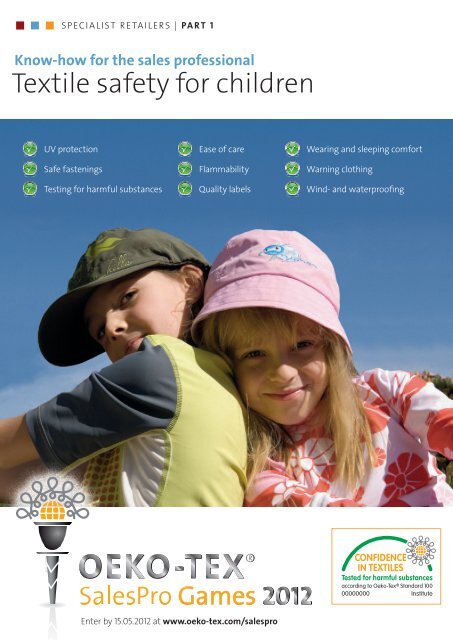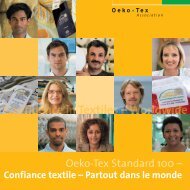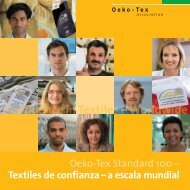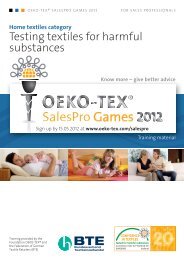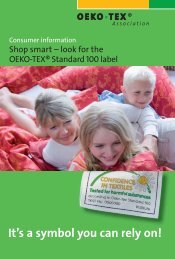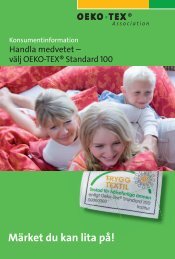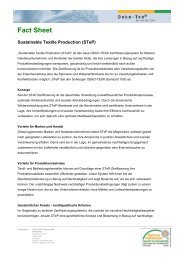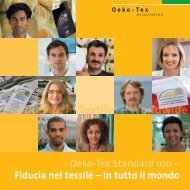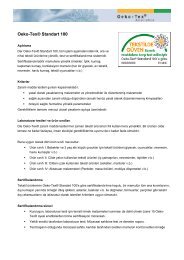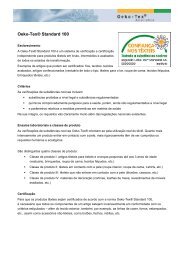OETS 100 Textile Safety for Children Part 1 EN - Oeko-Tex
OETS 100 Textile Safety for Children Part 1 EN - Oeko-Tex
OETS 100 Textile Safety for Children Part 1 EN - Oeko-Tex
Create successful ePaper yourself
Turn your PDF publications into a flip-book with our unique Google optimized e-Paper software.
SPECIALIST RETAILERS | PART 1<br />
Know-how <strong>for</strong> the sales professional<br />
<strong><strong>Tex</strong>tile</strong> safety <strong>for</strong> children<br />
UV protection<br />
Safe fastenings<br />
Testing <strong>for</strong> harmful substances<br />
Ease of care<br />
Flammability<br />
Quality labels<br />
Wearing and sleeping com<strong>for</strong>t<br />
Warning clothing<br />
Wind- and waterproofing<br />
Enter by 15.05.2012 at www.oeko-tex.com/salespro
KNOW-HOW FOR THE SALES PROFESSIONAL<br />
Always close at hand –<br />
textile safety <strong>for</strong> children<br />
An interview with Prof. Dr. Dirk Höfer of the Hohenstein Institute in<br />
Bönnigheim, Human biologist, textile expert and father of two children<br />
Interview with Prof. Dr. Dirk Höfer<br />
What role do textiles play in<br />
the life of a child?<br />
Prof. Dr. Höfer: <strong>Children</strong> are surrounded<br />
by textiles <strong>for</strong> virtually 24 hours a day,<br />
every day. In the case of clothing and<br />
equipment, of course, the focus is on<br />
protection from outside influences like<br />
the weather. From the very first day of<br />
life, textile materials always give a feeling<br />
of being protected. The same is true of<br />
their first toys which are usually also<br />
made of textiles. <strong><strong>Tex</strong>tile</strong>s are soft and<br />
supple, fulfil all kinds of functions and,<br />
not least, create a sense of identity with<br />
their colours and patterns.<br />
<strong><strong>Tex</strong>tile</strong>s <strong>for</strong> children have to<br />
be safe – what aspects do you<br />
take into account?<br />
Prof. Dr. Höfer: On the one hand, there<br />
is passive safety, i.e. the textiles must<br />
not pose any kind of threat to children<br />
from harmful substances, cords, easy<br />
flammability etc. On the other hand,<br />
though, textiles can also actively keep a<br />
child safe, e.g. by protecting it from strong<br />
sunlight or by using warning colours to<br />
protect from danger in traffic. <strong><strong>Tex</strong>tile</strong>s<br />
with an antimicrobial treatment can bring<br />
children with neurodermatitis some relief<br />
and even go beyond protecting from risk<br />
towards delivering a treatment.<br />
How can we recognize safe<br />
textiles?<br />
Prof. Dr. Höfer: Certain aspects like the<br />
presence of dangerous cords or the<br />
positioning of reflectors can be assessed<br />
by eye by the retailer. Many hazards,<br />
though, such as harmful substances<br />
or easy flammability, can only be ruled<br />
out by experts, and sometimes only in<br />
complex laboratory tests. Incidentally,<br />
the same also applies to many other<br />
quality criteria such as how com<strong>for</strong>table<br />
they are to wear or sleep in, and<br />
additional safety-relevant functions such<br />
as the UV protection factor of textiles or<br />
antimicrobial treatments. Here, product<br />
labelling can be a valuable guide <strong>for</strong><br />
retailers and consumers.<br />
What criteria should product<br />
labels meet in order to play<br />
this role?<br />
Prof. Dr. Höfer: It is important that the<br />
relevant certification processes are carried<br />
out by independent test institutes on<br />
the basis of internationally standardised<br />
test methods. Only then are the results<br />
comparable.<br />
To try to help a bit, my colleagues and I<br />
have put together a checklist <strong>for</strong> sales staff<br />
in specialist retail shops. From October,<br />
this will be available to download from<br />
www.oeko-tex.com/salespro – in <strong>Part</strong> 2<br />
of the Basic Knowledge leaflet, “<strong><strong>Tex</strong>tile</strong><br />
safety <strong>for</strong> children”.<br />
© axelhess.com
Products tested <strong>for</strong> harmful substances<br />
<strong>for</strong> delicate children’s skin<br />
<strong>Children</strong>’s sensitive skin<br />
Only by the end of puberty does<br />
human skin have all its own protective<br />
mechanisms. That is why independent<br />
testing <strong>for</strong> harmful substances is<br />
particularly important <strong>for</strong> textiles<br />
coming into contact with children’s<br />
delicate skin. <strong>Safety</strong> when buying<br />
textiles is provided by the OEKO-<br />
TEX® Standard <strong>100</strong> system with its<br />
“Confidence in textiles – tested <strong>for</strong><br />
harmful substances” label endorsing<br />
millions of products since 1992.<br />
Dermis Epidermis<br />
Sweat gland<br />
Horny cuticle<br />
Pigment<strong>for</strong>ming cells<br />
Skin cells<br />
Langerhans' cells<br />
Capillaries<br />
Merkel cells<br />
Veins<br />
and<br />
arteries<br />
Safe textiles<br />
Depending on the purpose <strong>for</strong> which<br />
they are to be used, textiles are<br />
divided into four product classes.<br />
The closer the skin contact, the<br />
higher the specifications. There are<br />
especially strict requirements <strong>for</strong><br />
textiles <strong>for</strong> babies and toddlers up to<br />
the age of 3 years. Special attention<br />
is paid to ensuring that no harmful<br />
substances can be released in saliva<br />
or perspiration.<br />
Tested quality<br />
The over <strong>100</strong> test parameters which<br />
are checked by the independent test<br />
institutes include excluding banned<br />
azo dyes, carcinogenic and allergenic<br />
dyes, pesticides and heavy metal<br />
contamination (e.g. nickel). Softeners<br />
(phthalates) and <strong>for</strong>maldehyde must<br />
not exceed a strict limit value. The<br />
textiles must also be colour-fast and<br />
have a skin-friendly pH value.<br />
Help with product selection<br />
One of the reasons why the<br />
“Confidence in <strong><strong>Tex</strong>tile</strong>s” label has<br />
established itself as a reliable<br />
decision-making aid <strong>for</strong> shoppers<br />
is because a product can only bear<br />
the label if all the components<br />
without exception meet the relevant<br />
requirements of the list of criteria.<br />
For example, children’s trousers will<br />
only be certified if not only the fabric<br />
but also the buttons, zips, yarns<br />
and so on that are used have been<br />
successfully tested. This means that<br />
the “Confidence in <strong><strong>Tex</strong>tile</strong>s” label<br />
stands <strong>for</strong> all-round security when<br />
buying textile products of all kinds –<br />
regardless of where the textiles were<br />
produced.
WWW.OEKO-TEX.COM/PRODUCTS<br />
WWW.OEKO-TEX.COM/BRANDS<br />
Functionality with no regrets<br />
In order to be able to serve all kinds of<br />
functions, today’s clothes use all kinds<br />
of materials and textile treatments<br />
such as dyes, prints and coatings. That<br />
is why, under the OEKO-TEX Standard<br />
<strong>100</strong>, all the components, materials<br />
and treatments are tested against the<br />
more than <strong>100</strong> parameters in the list<br />
of criteria.<br />
You can find some examples of<br />
the OEKO-TEX® test criteria in<br />
the photo on the right.<br />
Flocking<br />
Material: Viscose<br />
Possible contamination<br />
with extractable heavy<br />
metals, banned azo dyes<br />
Football shirt<br />
printed and flocked<br />
Material: Polyester<br />
Possible contamination with<br />
phthalates (from plastisol<br />
prints), tin organic<br />
compounds<br />
Football trousers<br />
Material: Polyester<br />
Possible contamination with<br />
allergenic dispersion dyes<br />
Socks<br />
Material: Polyester & Elastan<br />
Possible contamination with<br />
polycyclic aromatic<br />
hydrocarbons (PAH)
WWW.OEKO-TEX.COM/PRODUCTS<br />
WWW.OEKO-TEX.COM/BRANDS<br />
Keep fingers away from<br />
cords and drawstrings<br />
To avoid escalators and playgrounds<br />
becoming potential death-traps, cords<br />
and fastenings must be designed to<br />
be safe. The standard DIN <strong>EN</strong> 14682<br />
“<strong>Safety</strong> of children‘s clothing – cords<br />
and drawstrings on children‘s clothing”<br />
contains recommendations about how<br />
the fastenings on garments <strong>for</strong> children<br />
up to the age of 14 should be designed.<br />
Responsible manufacturers can confirm<br />
that their products are designed in<br />
accordance with the “Cord standard”<br />
by obtaining a certificate from an<br />
independent institute.<br />
The requirements<br />
of the “Cord standard”<br />
In general, the ends of drawstrings/<br />
cords, must not have any decoration<br />
or be knotted. Safe alternatives are<br />
secured or fused cord ends.<br />
Zip fasteners must not be more than<br />
75 mm in length.<br />
Neck:<br />
Garments must not have<br />
drawstrings with loose ends.<br />
Adjusting tapes are permitted, but<br />
must not be longer than 75 mm.<br />
Safe alternatives:<br />
Young child:<br />
- Hood with elastic straps inside<br />
the edge of the hood<br />
Older child:<br />
- Adjustment tapes with a<br />
maximum length of 75 mm<br />
- Width controlled by a pushbutton<br />
toggle<br />
Chest and waist<br />
General:<br />
Drawstrings at the waist must be<br />
secured with a cord stop.<br />
Safe alternatives<br />
- Drawstrings secured in the middle<br />
with elasticated waistband.<br />
- Decorative trim only on the front<br />
© Joujou_pixelio.de<br />
Long trousers<br />
General:<br />
On garments reaching to the<br />
ankle, any decorative or functional<br />
cords on the lower edge must be<br />
fully enclosed inside the garment.<br />
Age groups under<br />
the “Cord standard”<br />
Safe alternatives<br />
- No decorative or functional cords<br />
on the lower hem<br />
- Can be pulled tight using pushbutton<br />
Young child:<br />
0–7 years or up to 134 cm tall<br />
Older child:<br />
7–14 years or 135 – 182 cm tall
ANZEIGE<br />
© Pakhay Oleksandr - Fotolia.com<br />
Front and back<br />
General:<br />
No drawstrings or decorative or<br />
functional cords which come out at<br />
the back or have to be fastened at<br />
the back.<br />
- Sashes must not extend more<br />
than 360 mm beyond the<br />
fastening. Measured untied<br />
and from the point to which<br />
they are tied.<br />
None<br />
Safe alternatives<br />
In the “Know-how <strong>for</strong> the<br />
sales professional” series,<br />
the following titles have<br />
already been published<br />
and can be downloaded<br />
from www.oeko-tex.com/<br />
salespro<br />
General<br />
General:<br />
Loose ends of drawstrings/cords<br />
must not have any decorative trim<br />
or knot.<br />
- Zip fasteners must be no longer<br />
than 75 mm<br />
Safe alternatives<br />
- Secured or fused cord ends<br />
FACHHANDEL<br />
KNOW-HOW FÜR D<strong>EN</strong> VERKAUFSPROFI<br />
Basiswissen <strong>Tex</strong>tilien & Babyhaut<br />
“<strong><strong>Tex</strong>tile</strong>s & baby skin”<br />
“<strong><strong>Tex</strong>tile</strong> safety <strong>for</strong> children” <strong>Part</strong> 2<br />
(online shortly)<br />
UV protection<br />
Warning clothing<br />
Flammability<br />
Wearing and sleeping com<strong>for</strong>t<br />
Use your knowledge to score points and win!<br />
In the year of the summer Olympics, measure your specialist knowledge<br />
against colleagues from all over Europe in the “OEKO-TEX® SalesPro<br />
Games 2012”. The best sales staff in various product categories will be<br />
able to enjoy a trip to London to the Olympic Games or one of several<br />
valuable material prizes.<br />
www.oeko-tex.com/salespro<br />
More in<strong>for</strong>mation and contact: International OEKO-TEX® Association | Secretariat | Gotthardstrasse 61 | Postfach 2156 | CH-8027 Zürich | info@oeko-tex.com |<br />
www.oeko-tex.com | Foundation OEKO-TEX® GmbH | Kaiserstraße 39 | 60329 Frankfurt | Germany | info@certification-oekotex.com


